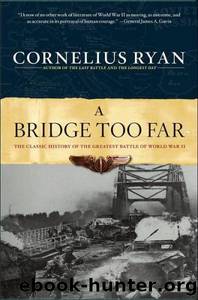Bridge Too Far by Ryan Cornelius

Author:Ryan, Cornelius [Ryan, Cornelius]
Language: eng
Format: epub
Tags: General, General Fiction, military history, Battle of, Arnhem, Second World War, Net, War, Europe, 1944, World history: Second World War, Western, History - Military, Western Continental Europe, Netherlands, 1939-1945, War & defence operations, Military, General & world history, History, World War II, Western Europe - General, Military - World War II, History: World, Military History - World War II, Europe - History
ISBN: 9780684803302
Publisher: Pocket
Published: 1974-04-11T06:00:00+00:00
on the high escarpment of the railway marshaling yards to the north,
waiting machine-gun crews opened up. And from the brickworks across
the Rhine multibarreled flak guns, firing horizontally, ripped into
Dobieâs battalion and flayed Fitchâs men as they tried to move along
the lower Rhine road. Fitchâs battalion, already badly mauled in the
fight-
since landing two days before, was now so cut to pieces by the unremitting flak fire that it could no longer exist as an effective unit. Men broke in confusion. They could go neither forward nor back. With virtually no protection on the open road, they were methodically mowed down. âIt was painfully obvious,â says Captain Ernest Seccombe, âthat the Jerries had much more ammunition than we did. We tried to move in spurts, from cover to cover. I had just begun one dash when I was caught in a murderous crossfire. I fell like a sack of potatoes. I couldnât even crawl.â Seccombe, who had been hit in both legs, watched helplessly as two Germans approached him. The British captain, who spoke fluent German, asked them to look at his legs. They bent down and examined his wounds. Then one of the Germans straightened up. âIâm sorry, Herr Hauptmann,â he told Seccombe. âIâm afraid for you the war is over.â The Germans called their own medics and Seccombe was taken to St. Elisabethâs Hospital. * * Throughout most of the Arnhem battle, the hospital was used by both British and German doctors and medics to care for their wounded. Seccombe, as a German prisoner, was moved to the small Dutch town of Enschede, about five miles from the German border. During his stay there, both legs were amputated. He was liberated in April, 1945.
By chance one of Fitchâs officers discovered the presence of Dobieâs forces on the lower road, and the men of the 1/ Battalion, despite their own heavy casualties, hurried forward, toward the pitiable remnants of Fitchâs group. Dobie was now hell bent on reaching the bridge, but the odds were enormous. As he moved up into the intense fire and leapfrogged over Fitchâs men, Dobie himself was wounded and captured (he later succeeded in making his escape); by the end of the day it was estimated that only forty men of his battalion remained. Private Walter Boldock was one of them. âWe kept trying to make it, but it was a disaster. We were constantly mortared, and German tanks whirled right up to us. I tried to get one with my Bren gun and then we seemed to be going backwards. I passed a broken water main. A dead civilian in blue overalls lay in the gutter, the water lapping gently around his body. As we left the outskirts of Arnhem, I knew somehow we wouldnât be going back.â
Fitchâs men, attempting to follow Dobieâs battalion, were shredded once again. The march had lost all meaning; after-action reports indicate the total confusion within the battalion at this point. âProgress was satisfactory until we reached the area of the dismantled pontoon bridge,â reads the 3rd Battalionâs report.
Download
This site does not store any files on its server. We only index and link to content provided by other sites. Please contact the content providers to delete copyright contents if any and email us, we'll remove relevant links or contents immediately.
The Fine Print (Dreamland Billionaires Book 1) by Lauren Asher(2472)
Fury of Magnus by Graham McNeill(2388)
The Last House on Needless Street by Catriona Ward(2269)
The Rose Code by Kate Quinn(2132)
A Little Life: A Novel by Hanya Yanagihara(1895)
Malibu Rising by Taylor Jenkins Reid(1846)
Luster by Raven Leilani(1831)
Transcendent Kingdom by Yaa Gyasi(1798)
Moonflower Murders by Anthony Horowitz(1783)
The God of the Woods by Liz Moore(1678)
The Lost Book of the White (The Eldest Curses) by Cassandra Clare & Wesley Chu(1595)
This Changes Everything by Unknown(1457)
The Midwife Murders by James Patterson & Richard Dilallo(1418)
The Lying Life of Adults by Elena Ferrante(1382)
The New Wilderness by Diane Cook(1379)
Wandering in Strange Lands by Morgan Jerkins(1359)
Written in the Stars by Alexandria Bellefleur(1342)
Ambition and Desire: The Dangerous Life of Josephine Bonaparte by Kate Williams(1328)
The Lying Life of Adults by Elena Ferrante;(1263)
